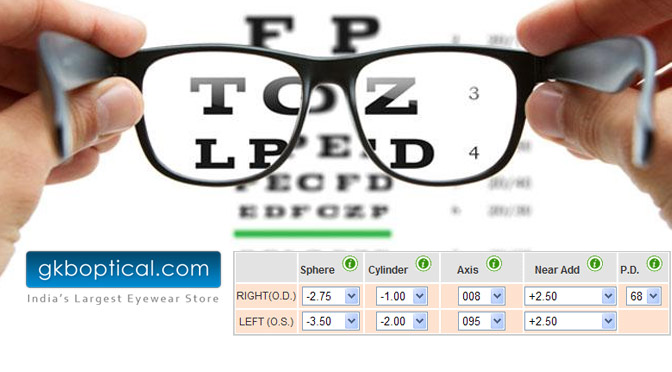GKB Opticals is your one stop destination for all eyewear requirements, from sunglasses to eyeglasses to contact lenses, you will find a plethora of choice. While most online websites might have a really complicated and confusing prescription lens ordering portal, GKB Opticals has simplified the process; but it surely makes it easier when you have a good knowledge about the different parts of your prescription.
SPH:
SPH or Sphere is the value that indicates the amount of vision correction required for farsightedness or nearsightedness. If it’s a Positive sign, it means you have a farsighted prescription; if it’s a negative value, then you are nearsighted.
CYL:
CYL means Cylinder power and this is the value that’s used to denote the amount of astigmatism you have. This value can be a positive or a negative value and if left blank then it means you don’t have astigmatism.
AXIS:
Axis is the value that denotes the direction of your astigmatism. The direction of your astigmatism will be a value between 1 to 180 degrees and will also indicate the angle at which the lens should be set into the frame.
PRISM:
‘PRISM’ of ‘PRISMATIC POWER” denotes the amount of Prismatic power required for your spectacles. This is usually applicable for people who have eyes that have problem working together simultaneously. This value is usually used to align the eyes and also correct the muscle imbalance that is common among patients with such eye problems. Also it is used to eliminate and reduce the double images and headaches that are likely to appear from the eye problem.
BASE:
The BASE value is mainly used by the optical lens manufacturing lab to indicate where your prismatic power should be applied for proper lens dispersal. This is important value that accompanies the PRISM value and is mainly required by the Optical lab.
VA:
Visual Acuity or VA stands for the standard of vision in both eyes after the corrections. This value is represented in fractions. The larger the denominator, the worse the eyesight in that particular eye.
ADD /NEAR:
ADD or NEAR is the value which represents the NEAR ADDITION and is used to indicate the amount of additional correction required for better reading. This is the value of eye correction required for reading at the arm’s length.
DISTANCE: If you’re getting Bifocal lenses, this value will tell the lens manufacturing lab the amount of correction to be added to the top segment of the lens. Also the value specifies the amount of correction required to improve far vision.
PD: This many or may not be mentioned on the prescription and sometimes you may need to ask your doctor to measure it for you. PD or Pupilary Distance is the distance between the two centers of your pupils. This distance is usually measured by Millimeters and is usually written in two formats. One format mentions the total distance from one pupil to the other and in some cases the distance from the centre of the nose is mentioned separately. For the first type, the value can be denoted in this way: 55(55m) or for the each eye method the values can be L28 R 29.
So, these are all the information you will need to understand your prescription. Understand and take note of your prescription for the best online ordering experience and even if you’re getting lenses offline, knowing the abbreviations and their meanings will surely make you a smarter shopper.

